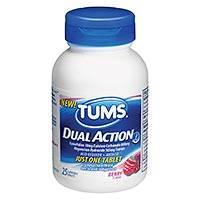Tums Dual Action Interactions
There are 529 drugs known to interact with Tums Dual Action (calcium carbonate / famotidine / magnesium hydroxide), along with 10 disease interactions, and 2 alcohol/food interactions. Of the total drug interactions, 22 are major, 424 are moderate, and 83 are minor.
- View all 529 medications that may interact with Tums Dual Action
- View Tums Dual Action alcohol/food interactions (2)
- View Tums Dual Action disease interactions (10)
Most frequently checked interactions
View interaction reports for Tums Dual Action (calcium carbonate / famotidine / magnesium hydroxide) and the medicines listed below.
- acetaminophen / oxycodone
- Acidophilus Probiotic Blend (lactobacillus acidophilus)
- Adderall (amphetamine / dextroamphetamine)
- albuterol / ipratropium
- Aloe Vera Burn Relief Spray with Lidocaine (lidocaine topical)
- alpha-lipoic acid
- alprazolam
- amiodarone
- amlodipine
- amoxicillin
- Asmanex Twisthaler (mometasone)
- Aspir 81 (aspirin)
- aspirin
- atenolol
- atropine / diphenoxylate
- bacitracin topical
- biotin
- carvedilol
- CoQ10 (ubiquinone)
- gabapentin
- hydrocodone
- levothyroxine
- Lexapro (escitalopram)
- lisinopril
- melatonin
- Neupro (rotigotine)
- Oyster Shell Calcium (calcium carbonate)
- Renal Caps (multivitamin)
- venlafaxine
- Xanax (alprazolam)
Tums Dual Action alcohol/food interactions
There are 2 alcohol/food interactions with Tums Dual Action (calcium carbonate / famotidine / magnesium hydroxide).
Tums Dual Action disease interactions
There are 10 disease interactions with Tums Dual Action (calcium carbonate / famotidine / magnesium hydroxide) which include:
- phosphate calcifications
- cardiac contraction/conduction
- malabsorption
- renal dysfunction
- sarcoidosis
- GI bleeding
- inflammatory bowel disease
- intestinal obstruction disorders
- renal dysfunction
- renal dysfunction
More about Tums Dual Action (calcium carbonate / famotidine / magnesium hydroxide)
- Compare alternatives
- Drug images
- Latest FDA alerts (1)
- Side effects
- Dosage information
- During pregnancy
- Drug class: H2 antagonists
Related treatment guides
Drug Interaction Classification
| Highly clinically significant. Avoid combinations; the risk of the interaction outweighs the benefit. | |
| Moderately clinically significant. Usually avoid combinations; use it only under special circumstances. | |
| Minimally clinically significant. Minimize risk; assess risk and consider an alternative drug, take steps to circumvent the interaction risk and/or institute a monitoring plan. | |
| No interaction information available. |
See also:
Further information
Always consult your healthcare provider to ensure the information displayed on this page applies to your personal circumstances.


